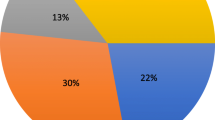Abstract
Aim
Knowledge about nurses’ error perception is crucial for establishing a sustainable risk management. This paper presents categories and frequencies of errors as identified by nurses. The cross-sectional study results provide further knowledge for professional and organizational development.
Subject and methods
Data from 1,100 German nurses working in 30 hospitals and 46 nursing homes were collected using a self-administered questionnaire. This paper firstly presents results from a content analysis of nurses’ descriptions of errors and, secondly, results on frequencies of predefined nursing errors (closed-ended, ordinal frequency estimation). Thirdly, it compares the answers of hospital nurses with those of nurses employed in nursing homes and finally it compares answers of participant groups defined by sex or migration background.
Results
In the open-ended section, errors described by 60.5 % of the participants concerned medical diagnosis/therapy. 20.7 % had experienced errors in hands-on care, while errors in communication with patients were noted by 3.7 %. In contrast, when offering predefined activities in the questionnaire’s closed-ended part, indicated frequencies of errors stressed issues of hands-on care and documentation. Significant differences exist between participants from both settings regarding direct care and relationship building. Sex and migration background were related to frequency estimations.
Conclusions
Findings point to shortened professional perspectives in the debates on risk and safety. This might lower nurses’ compliance in risk management systems. The influence of health professionals’ sex and migration background on their error perception needs further exploration. Field specific approaches for error prevention are needed.


Similar content being viewed by others
Notes
The external institute was included into the preparation of this article in person of Ronja Foraita.
References
Arndt M (1994a) Nurses’ medication errors. J Adv Nurs 19:519–526
Arndt M (1994b) Medication errors: research in practice—how drug mistakes affect self-esteem. Nurs Times 90:27–30
Balas MC, Scott LD, Rogers AE (2004) The prevalence and nature of errors and near errors reported by hospital staff nurses. Appl Nurs Res 17(4):224–230
Balas MC, Scott LD, Rogers AE (2006) Frequency and type of errors and near errors reported by critical care nurses. Can J Nurs Res 38:24–41
Benner P, Malloch K, Sheets V, Bitz K, Emrich L, Thomas MB, Bowen K, Scott K, Patterson L, Schwed K, Farrell M (2006) TERCAP: creating a national database on nursing errors. Harv Health Policy Rev 7:48–63
Board A, for the Concerted Action in Health Care (2003) Report 2003: health care finance—user orientation and quality, Bonn, Germany
Cook AF, Hoas H, Guttmannova K, Joyner JC (2004) An error by any other name. Am J Nurs 104:32–44
Evans J (2009) Prevalence, risk factors, consequences and strategies for reducing medication errors in Australian hospitals: a literature review. Contemp Nurse 31:176–189
Federal Statistical Office of Germany (2011a) Hospital statistics: basic data. Federal Statistical Office, Wiesbaden, Germany
Federal Statistical Office of Germany (2011b) Pflegestatistik 2009: Pflege im Rahmen der Pflegeversicherung—Deutschlandergebnisse. Federal Statistical Office, Wiesbaden, Germany
Gurwitz JH, Sanchez-Cross MT, Eckler MA, Matulis J (1994) The epidemiology of adverse and unexpected events in the long-term care setting. J Am Ger Soc 42:33–38
Habermann M (2007) Knowing the negatives in nursing. Pflege 20:317–319
Inoue K, Koizumi A (2004) Application of human reliability analysis to nursing errors in hospitals. Risk Anal 24:1459–1473
Institute of Medicine (2000) To Err is human: building a safer health system. National Academy Press, Washington, DC
Institute of Medicine (2001) Crossing the quality chasm: a new health system for the 21st century. National Academy Press, Washington, DC
Krohwinkel M (1993) Der Pflegeprozess am Beispiel von Apoplexiekranken: eine Studie zur Erfassung und Entwicklung Ganzheitlich-Rehabilitierender Prozesspflege. Nomos, Baden-Baden, Germany
Medical Review Board of the Statutory Health Insurance Funds (2001) Grundsatzstellungnahme Dekubitus. Essen, Germany
Medical Review Board of the Statutory Health Insurance Funds (2004) Qualität in der ambulanten und stationären Pflege. 1. Bericht des Medizinischen Dienstes der Spitzenverbände der Krankenkassen nach § 118, Abs. 4 SGB XI. Essen, Germany
Medical Review Board of the Statutory Health Insurance Funds (2007) 2. Bericht des MDS nach § 118 Abs. 4 SGB XI. Qualität in der ambulanten und stationären Pflege. Essen, Germany
Medical Review Board of the Statutory Health Insurance Funds (2012) 3. Bericht des MDS nach § 114a Abs. 6 SGB XI. Qualität in der ambulanten und stationären Pflege. Essen, Germany
Meurier CE, Vincent CA, Parmar DG (1997) Learning from errors in nursing practice. J Adv Nurs 26:111–119
Meurier CE, Vincent CA, Parmar DG (1998) Nurses’ responses to severity dependent errors: a study of the causal attributions made by nurses following an error. J Adv Nurs 27:349–354
Mitchell P (2002) Nursing is essential to improving patient safety. J Adv Nursing 38:109–110
Sanghera IS, Franklin BD, Dhillon S (2007) The attitudes and beliefs of healthcare professionals on the causes and reporting of medication errors in a UK Intensive care unit. Anaesth 62:53–61
Schrappe M (2005) Patient safety and risk management. Med Klinik 100:478–485
Wingenfeld K, Schaeffer D (2001) Consumer perspective and quality development in ambulatory nursing care. Z Gerontol Geriatr 34:140–146
Conflict of Interest
The authors declare that they have no conflict of interest.
Funding
This research was funded by the German Federal Ministry of Education and Research, Grant Number 01GT0607.
Author information
Authors and Affiliations
Corresponding author
Rights and permissions
About this article
Cite this article
Habermann, M., Foraita, R. & Cramer, H. Categories of errors and error frequencies as identified by nurses: results of a cross-sectional study in German nursing homes and hospitals. J Public Health 21, 3–13 (2013). https://doi.org/10.1007/s10389-012-0531-x
Received:
Accepted:
Published:
Issue Date:
DOI: https://doi.org/10.1007/s10389-012-0531-x




